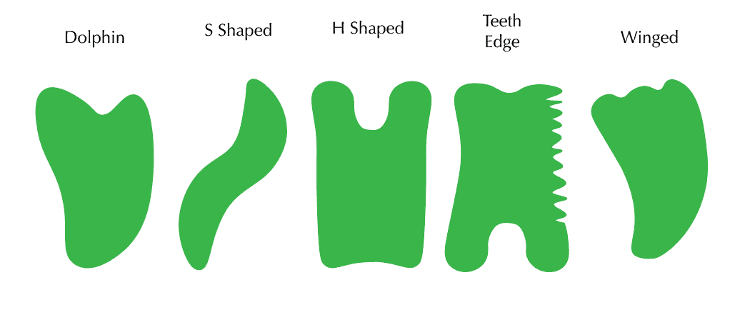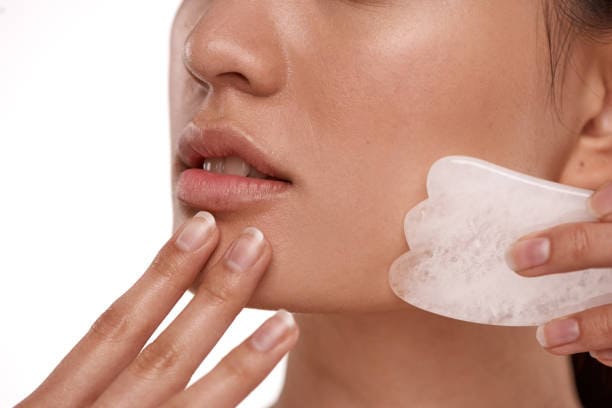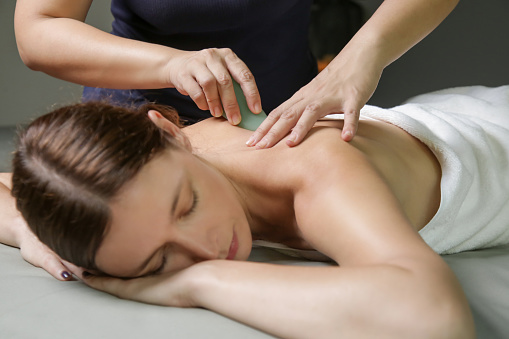Gua Sha Tools – How To Give Yourself A Spa Quality Gua Sha Massage

What gua sha tools should you buy for what purposes, and what are the overall benefits? In this post, you will learn more about the recent internet sensation – the Gua Sha method. Here are the topics we’ll discussed in this post:
- What is Gua Sha?
- What Does Gua Sha Do?
- Benefits Of Gua Sha Tools
- How To Use Gua Sha?
- Techniques for Facial Gua Sha Massage
- How to Choose What Gua Sha Tools to Use?
- Different Gua Sha Shapes to Use
- Best Oils to Use With Gua Sha Tools
- How Often Should You Gua Sha?
- Are There Any Cons to Gua Sha?
- Who Shouldn’t Use Gua Sha Tools?
What is Gua Sha?
Although this technique has gotten lots of attention on social media recently, it has been practiced for centuries. In traditional Chinese healing practices, gua sha tools have been used as alternative therapy to treat muscle pains and help with blood flow. Gua translates to “stroke” or “scrape”, while sha refers to the red spots that appear on the skin afterwards. This technique has also been referred to as ‘spooning’ or ‘coining.’ Since it’s common practice to use a hard object like a coin or spoon along the skin.
Gua sha is also believed to break up the ‘chi’ in the skin. Chi is considered the energy that flows through you and everything in the universe. It is believed to connect all living things energetically, physically, emotionally, and spiritually. In many cultures, properly taking care of your body’s chi would also bring you good health. So, any pain or tension in the body can be a sign of imbalanced chi.
The gua sha tools were originally used in full body treatments. That’s because these treatments are an effective method in helping conditions with chronic pain, such as arthritis and fibromyalgia. It works by scraping a flat smooth-edged tool, often made of stone, in short and long strokes along the body. And so, improving circulation and relieving tension in muscles.
However, now gua sha is commonly used in skincare to help with puffiness and sinus pressure. Similarly to a jade roller, this method is used to massage the facial muscles. Although a roller requires less pressure and may not give all the same benefits of a gua sha.

Benefits of Gua Sha Tools
There are plenty of benefits that come with practicing gua sha. Firstly, adding this into your routine can be a great meditation technique. It gives you an opportunity to slow down, relax, and focus on your breathing. Really any opportunity for self-care is a great stress reducer. Even if it’s only for a couple minutes a week. Or if you can splurge, get a spa facial with gua sha tools. Spa facial has advantage of having someone else perform the treatment while you relax and meditate, which you can’t do when you’re doing the treatment by yourself.
There are physical benefits like reducing the appearance of facial wrinkles and stimulating collagen growth. It’s even been referred to as the natural facelift because it can bring back a youthful glow. Besides being used for the face and muscle tightening, this process can be used on the scalp for thicker and faster hair growth.
A major advantage is that it helps with pain mostly due to muscle tension. It even works for breast-feeding mothers that are struggling with overfilled milk ducts. Using gua sha on the breast may relieve pain and make it less painful to feed.
And for those that suffer from migraines and headaches, a study from 2007 found that gua sha was effective in reducing pain.
Another benefit to gua sha is that it can be safely done at home without costly visits to a professional. All you need is gua sha tools and face oil. Once you have the movements down there is nothing stopping you from adding it to your morning routine.
How to use Gua sha?
Before applying a gua sha, you should thoroughly clean your face. It is also best to make sure that your tool itself is clean. Since you will be rubbing it back and forth on your face you want to avoid adding any bacteria or dirt. And if you want to add a cooling effect, you can put your tool in the refrigerator.
Now it’s time to gua sha. You should always add a rich organic face oil to avoid pulling at the skin. Apply two to three drops of your desired oil onto the face. I love using Plant Mother’s oil-based Vitamin C serum. It is a healthy skin food with many benefits to your skin.
Now, the motion you move the tool is the most important. The angle and pressure make a difference. It will take time to get the hang of it. If you don’t know how to start you can always follow along with a tutorial. Then using the smooth-edged stroke upwards in outward directions. It is advised to start on another part of the body before working on the face due to its sensitivity.
Following the natural facial contours, use the smaller curves on smaller contours of the face like the jaw’s ridge, nose, and brow. Use larger sides for larger areas like the cheeks and forehead. Repeat the strokes 3-10 times with even pressure. You can do this for 5-10 minutes a couple times a week. Depending on how sensitive your skin is, you can do it for longer periods. In the beginning, be careful around the eyes since that skin is especially delicate.

Techniques for facial gua sha massage
For lymphatic drainage, there is no need to press as hard since the lymphatic system sits right below the skin. You can even use your hand to stimulate the lymph nodes by laying a flat hand making circular motions on your collarbone and below your ear. Then with a gua sha, sweep the longer side from the earlobe down to the neck to clear any lymphatic fluid. Repeat this on both sides of the face. Then you work the tool underneath the jaw towards the base of the ear with short strokes. In the same direction follow this pattern along the cheek and then under the eye and close to the bridge of the nose. Next scrape from the middle of the forehead to the base of the ear. Finally, you will use small strokes from the ear down to the collarbone again.
For migraines or headaches, use a heart shaped curve on your back at the bottom of your neck upwards. Then with the longer side, from the shoulders upwards to behind the ears. Then again with the heart shape side along the jaw towards the base of the ear then down towards the neck. Lightly wiggle your gua sha at your temples and slide behind your ears. With light pressure on the inner corner of your eyes follow the browbone outwards towards the temples. Then from the hairline to the back of the head. Repeat each step on both sides.
For muscle tension, dig deeper than normal into the muscle area with short repetitive strokes in the direction of the muscle fibers. This is commonly used for the legs, arms, neck, and back to relieve pain.
How to choose what Gua Sha Tools to use?
Gua sha tools come in all sorts of shapes and materials. The most common tools are made from jade or quartz. This is because crystals are believed to contain healing properties. Certain stones are believed to be associated with different energy sources in the body. In our article about fertility crystals and chakra stones, you can learn more about the body’s chakras, in addition to the benefits of certain crystals.
When it comes to materials, there are plastic options, but it is better to invest in an authentic crystal. Especially when you want to cool or warm the tool, real stone works best.
- Jade has a natural cooling effect that helps reduce puffiness. Its anti-aging properties work great for wrinkles and loose skin. Jade has also been traditionally used for purging toxins and can encourage lymphatic drainage.
- Rose quartz can soothe the skin by alleviating inflammation, puffiness, and redness. Also reducing dark circles under eyes. Rose quartz is associated with the heart chakra in addition to being a calming stone.
- Amethyst is a stone often used for anxiety and stress. When it comes to skincare, amethyst oxygenates the skin. It is also known to improve sleep, and therefore, will help the skin look healthier.
- Bian stone works by increasing oxygen and nutrition supply to various body organs. When used on the body, the stone emits ultrasonic impulses. Therefore, it’s great for improving blood circulation and purifying the blood.
- Stainless steel is great for sensitive skin types. Steel has anti-bacterial properties which is why it’s commonly used for surgery equipment. It too has a natural cooling effect that reduces puffiness and inflammation.
Different Gua Sha Shapes to use
There are different shapes of gua shas used for different uses. Essentially most tools can be used for most of the body, but some are just better at certain areas. Listed below are just some of the many different shapes that you can get.
- Dolphin: The V side is primarily used for lifting the jawline and easing discomfort while the remaining sides work for softening fine lines and lymphatic drainage.
- S shaped: This tool is great for the neck, back, and shoulder tension. Also, it works well for relieving sinus congestion and headaches by using the corners at the temples and brow bones. Can also be great for getting to a smaller area like the inner corner of the eyes.
- H shaped: This gua sha tool is great for the face and body. The root is great for the jaw and chin while the flatter sides can be used for muscle tension around the body.
- Teeth Edge: Commonly used for larger areas in order to promote circulation, this toll is used on the forehead, cheeks, and chin. It can even promote hair growth by using it on the scalp.
- Winged: A multipurpose tool with easy maneuverability. Similarly to the dolphin gua sha, the two smoother sides can be used for arms, legs, and neck while the little bumps can be used for the nose and brows.
Best Oils to use with gua sha tools
A facial oil or face serum helps glide the tool across the skin. In addition to helping the serum absorb, you won’t be pulling at the skin. When trying to decide what to use, it is great to pair it with a serum that will benefit your skin.
For instance, retinol serums work to help cell turnover, encourage collagen growth, and reduce the appearance of wrinkles. Although, some synthetic retinol serums can be harsh on sensitive skin. Plant Mother’s retinol serum is great for sensitive skin and 100% natural. Made entirely from organic botanicals, this serum helps with anti-aging by building collagen and cell regeneration.
Additionally, Plant Mother’s vitamin C serum contains plant-based vitamin C, natural niacinamide, and vitamin E. With over 200 antioxidants this product protects skin against sun damage and premature aging. In addition to stimulating collagen and working as an anti-inflammatory.
Both of these nutritious serums would be a great choice for any of the gua sha tools and treatments you decide to use.
What does gua sha do?
Gua sha works primarily to break down stagnant blood, improve circulation, and relieve muscular tension. In traditional Asian medicine, they believed that stagnant blood led to pains and illnesses. Therefore, gua sha practice is used to relieve tension in the body and aid joint pains.
This non-invasive procedure works by causing light bruising under the skin’s surface. Hence breaking up congested skin, helping against acne build up, and stimulating collagen growth. So, any redness or bruising that appears is a sign of blood renewal.
It is also an effective method in draining the lymphatic system. Consider the lymphatic system the body’s sewerage system. The body’s lymphatic system is a crucial part in one’s immune system draining lymph fluid from all over the body. Therefore, gua sha tools assist the body in flushing out toxins, bacteria, and viruses.
How often should you gua sha?
There is no harm in doing it every day. If you don’t think you can commit to that, you can do it at least 2-3 times a week. Each time you can gradually add more pressure depending on your skin’s tolerance. This treatment is becoming more popular, even as part of men’s skincare routine.
Are there any cons to Gua Sha?
There are little to no downsides to gua sha tools other than redness and bruising. However, this depends on the applied pressure and sensitivity of your skin. And after frequent use, the skin will become more tolerable and less prone to bruising. In the beginning it can be a tad painful or discomforting but that can be avoided by applying less pressure.
Who shouldn’t use Gua Sha Tools?
It is not recommended to use gua sha tools for people with clotting disorders or people taking blood thinners, due to bruising. It is also not recommended to do it for a few weeks after procedures like Botox or fillers. This applies to any type of botulin toxins such as Dysport vs Botox.
Also, if you have had a recent surgery or invasive treatment, it is best to wait for the tissue to fully heal before proceeding.
Finally, is you struggle with acne or any active skin inflammation, it’s best to wait until your skin is healed before you do gua sha.
Medical Disclaimer
This content is for informational and educational purposes only. It is not intended to provide medical advice or to take the place of such advice or treatment from a personal physician. All readers of this content are advised to consult their doctors or qualified health professionals regarding specific health questions. The publisher of this content does not take responsibility for possible health consequences of any person or persons reading or following the information in this educational content. All viewers of this content, especially those taking prescription or over-the-counter medications, should consult their physicians before beginning any nutrition, supplement, skincare product, or lifestyle program.
Related Sources & References:
